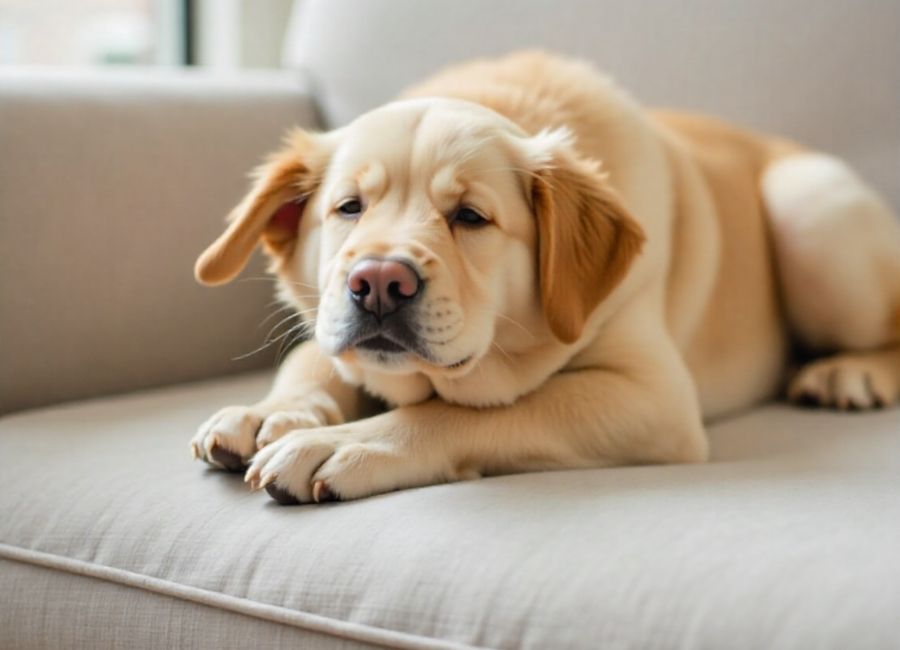Accidents are a normal part of having pets. Even dogs that are usually well-trained can slip up, and when that happens, your furniture often takes the hit. If you don’t clean it up right away, the strong smell of dog urine can stick around for weeks, and the stains might not come out at all.
The good news is that with the right steps and supplies, you can get rid of both the smell and the stains on most types of furniture. This guide will show you how to clean up dog urine from different materials, why it’s important to act fast, and how to help prevent future accidents.
No matter if the accident just happened or you found an old stain, these tips will help you bring your furniture back to normal and get rid of stubborn smells.
Why Dog Urine is So Difficult to Clean
Dog urine is tough to clean because it has several tricky ingredients. Urea turns into ammonia, which causes that strong smell. Uric acid forms crystals that stick to surfaces, and proteins in the urine feed bacteria that keep making odors even after the first mess or accident.
The longer the urine sits, the deeper it penetrates furniture fibers and padding. This is why immediate action is your best defense against permanent damage and lingering smells.
Essential Supplies for Cleaning Dog Urine
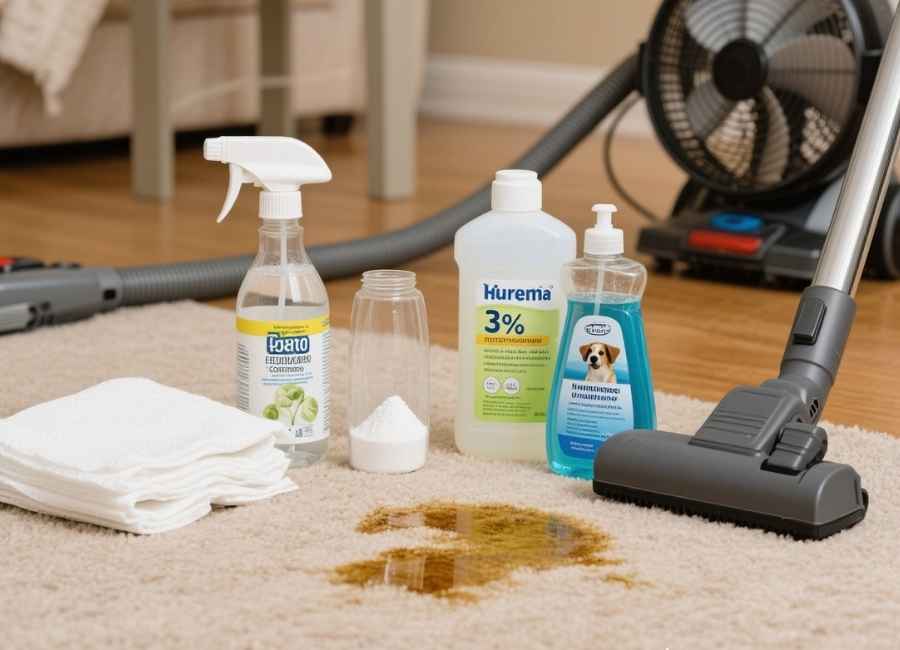
Before you start cleaning, gather these materials:
- Paper towels or clean cloths
- White vinegar
- Baking soda
- Liquid dish soap
- Hydrogen peroxide (3% solution)
- Enzyme cleaner specifically designed for pet stains
- Spray bottle
- Vacuum cleaner
- Fan or hair dryer
Avoid using ammonia-based cleaners, as these can cause problems. Don’t use cleaners with ammonia, since they can make your dog want to pee in the same place again.
Step 1: Blot immediately
Use paper towels to absorb as much urine as possible. Press firmly and replace towels frequently. Don’t rub, as this pushes the urine deeper into the material.
Step 2: Apply the vinegar solution
Mix equal parts white vinegar and water in a spray bottle. Spray the affected area generously and let it sit for 5-10 minutes. The acid in vinegar neutralizes the ammonia in urine.
Step 3: Blot again
Remove the vinegar solution with clean towels, pressing firmly to extract moisture from deep within the cushions.
Step 4: Apply baking soda
Cover the damp spot with plenty of baking soda. It will soak up extra moisture and help remove smells. Leave it there overnight.
Step 5: Vacuum thoroughly
Vacuum up all the baking soda, going over the area a few times to make sure you get it all.
For Set-in Stains
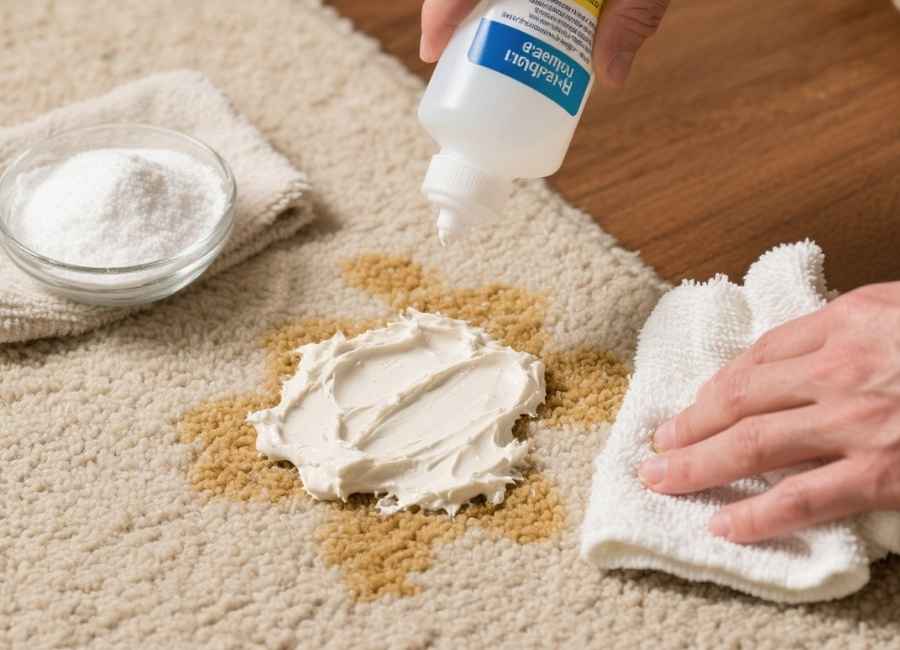
Older stains require a more aggressive approach:
Step 1: Create an enzyme cleaner paste
Mix the enzyme cleaner with baking soda to form a thick paste. Apply this directly to the stain and work it in gently.
Step 2: Cover and wait
Place a damp cloth over the paste and let it work for several hours or overnight. Enzymes need time to break down the uric acid crystals.
Step 3: Rinse and extract
Remove the paste with clean, damp cloths. Extract as much moisture as possible.
Step 4: Apply hydrogen peroxide solution
If the stain is really tough, mix one part hydrogen peroxide with two parts water. Try it on a hidden spot first, since peroxide can lighten some fabrics. Use just a little and blot it up right away.
Material-Specific Cleaning Methods
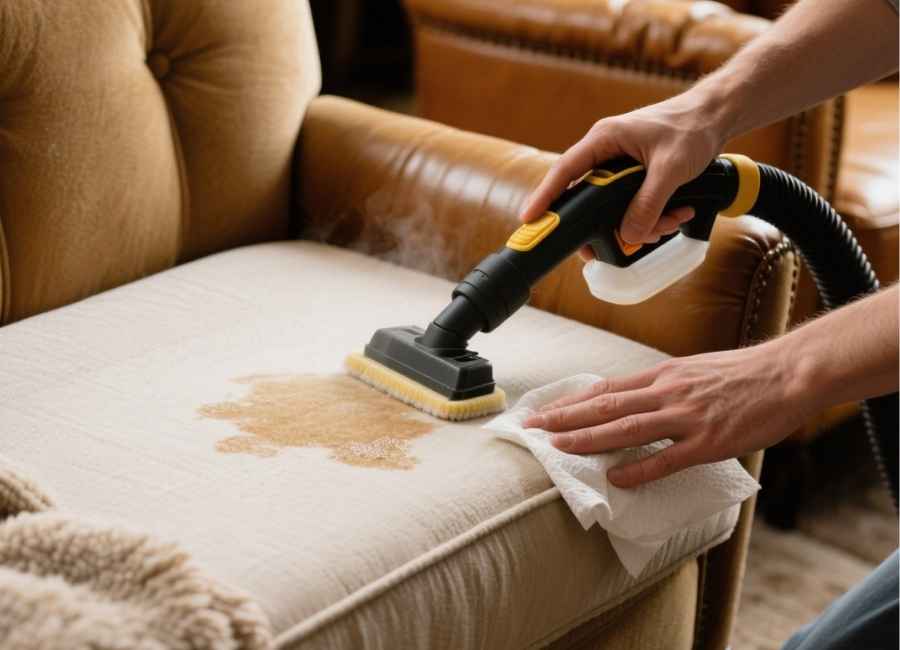
Fabric Upholstery
Fabrics like cotton and linen are usually easier to clean than synthetics. After the basic cleaning, you might need to use a steam cleaner or wet vacuum for a deeper clean.
If you have delicate fabrics like silk or wool, it’s best to let a professional handle the cleaning so you don’t risk damage.
Leather Furniture
Leather requires special care:
- Blot immediately with paper towels
- Clean with a leather-specific cleaner
- Apply leather conditioner once dry.
- Don’t use vinegar or baking soda on leather, since they can make it crack.
Microfiber and Synthetic Materials
Enzyme cleaners usually work well on these materials. Synthetic fibers don’t soak up urine as much as natural ones, so cleaning is easier if you get to it fast.
Advanced Cleaning Techniques
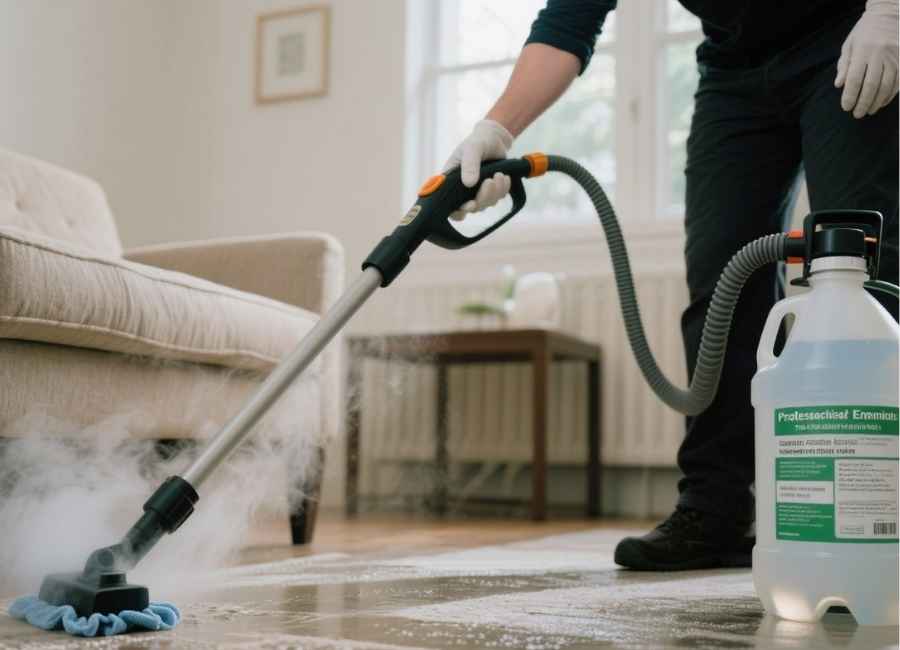
Using a Steam Cleaner
If you have strong, deep odors, a steam cleaner can really help. The heat breaks down the smelly stuff, and the machine pulls out moisture and dirt.
Always use distilled water in steam cleaners to prevent mineral buildup.
Professional Enzyme Treatments
Store-bought enzyme cleaners have special bacteria that eat away the stuff in urine that causes smells. These products usually work better than homemade solutions for tough odors.
Apply the enzyme. Follow the instructions on the enzyme cleaner and give it enough time to dry for the best results. Future Accidents
Training and Routine
Please keep your dog’s bathroom schedule regular and reward them when they do well. If accidents keep happening, check with your vet to rule out any health problems.
Furniture Protection
Consider using washable covers or waterproof protectors on your furniture, especially if you’re training a puppy or have an older dog with bladder issues. Immediate Response Plan
Keep your cleaning supplies somewhere handy so you can deal with accidents right away. The sooner you clean up, the more likely you are to get rid of stains and smells completely.
When to Call Professionals
Some situations require professional intervention:
- Expensive or antique furniture
- Large or multiple stains
- Persistent odors after multiple cleaning attempts
- Delicate materials like silk or vintage fabrics
Professional cleaners have the right tools and products to handle tough messes without harming your furniture.
Common Mistakes to Avoid
Don’t use cleaners with ammonia, since they can make your dog want to pee there again. Avoid rubbing stains, because that pushes the urine in deeper. Also, don’t use heat like a hair dryer on fresh stains, since heat can set the proteins for good.
Most importantly, don’t get discouraged if it takes more than one try. Strong odors sometimes need a few rounds of cleaning to go away completely.
Restoring Your Furniture and Home
Getting dog urine out of furniture takes patience, the right supplies, and quick action. It can take some time, but if you follow these steps, you can get rid of both stains and smells.
Remember that every accident is a learning opportunity. Use these incidents to identify patterns in your dog’s behavior and adjust your routine accordingly. With consistent training and quick response to accidents, you can maintain both a clean Home and a happy relationship with your furry Family member.
Make sure you always have cleaning supplies on hand. Buying good enzyme cleaners and the right tools now will save you time, money, and stress later, and help your furniture last longer.







